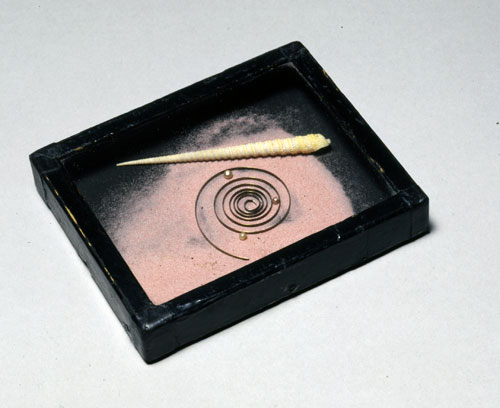
Beyond proffering the aesthetic value of whatever works have been selected, exhibitions such as “Sand: Memory, Meaning and Metaphor” at the Parrish Art Museum in Southampton serve as constant reminders of the continually evolving role of curators in the contemporary art world.
In the past, a curator’s assignment derived from little more than an impressive amount of art historical knowledge, using research skills to accumulate the best (or best known) works for a particular exhibit. Indeed, the historical definition of the curator’s job was recently summed up by Niru Ratnam as “a straightforward enough, if onerous, profession.”
Now, though, as some museums have come to resemble extensions of the commercial gallery scene amid a broadening international art explosion, the demands on curators—to develop themes that go beyond merely reflecting current popular trends—are both profound and necessary. Rather than serving as an echo chamber for the marketplace or history books, imaginative curators in contemporary art are instead, as the English curator Teresa Gleadowe noted, “concerned with the whole physical and intellectual experience of an exhibition.”
While nobody is naive enough to believe that this kind of intellectual dedication actually occurs all the time, it seems to have been more the rule than the exception under the Parrish’s chief curator, Alicia Longwell, in the eight years I’ve been writing this column.
Even if there have been instances when an exhibit may have fallen somewhat short between conception and realization (the themed show revolving around William Merritt Chase’s “The Bayberry Bush” comes to mind), shortcomings have never been the result of a lack of effort or imagination.
From a painter’s perspective, this dedication to imaginative themes is particularly apparent in the current show, “Sand: Memory, Meaning and Metaphor.” This is due to the fact that Ms. Longwell’s concept has little to do with any specific movements in art history and instead focuses simply on the inventive and ingenious ways that artists make use of
unlikely materials and subject matter in order to reach a specific goal.
This is not meant to suggest a personal lack of respect for sand, which, after all, is one of Earth’s most fundamental elements. Still, sand does not have the historically important role of other elements (such as salt, for example) nor does it historically have much to do with creativity, except in Native American and Tibetan religious ceremonies.
What it does offer for artists—which is reflected in the exhibit’s division into specific themes—is both a physicality and a psychological aspect, which, in combination, can be highly emotive as it strikes individual chords of consciousness on the part of both the artist and the viewer.
In the first section, “Time, Trace and Memory,” for example, sand becomes an essentially elegiac component, representing the inevitabilities of time’s passage as well as our own corporeal insignificance. In “The Alchemy of Sand: Physical and Metaphysical Ballast,” meanwhile, the focus is on the ways artists have used sand primarily for its specific physicality and texture.
Of particular interest in the exhibition are a number of photographs by Felix Torrez-Garcia of footprints on a beach (appearing in various locations throughout the exhibition) that are silent yet evocative and somewhat melancholy reveries on both memory and loss.
This theme is also echoed in Richard Misrach’s large “Untitled #704-03” (chromagenic print on Plexiglas, 2003) which powerfully depicts a solitary person lying on an empty beach, pictured from a dizzying perspective above the figure. Inspired by the events of 9/11, the work is effective both for its powerful use of pictorial angle and also for the compositional framework that underscores mankind’s
relationship to nature.
Perhaps the most surprising works in the exhibition, though, are by an artist few have ever heard of but whose art is sort of familiar to anyone who has seen colored sand in bottles at quaint gift shops. In the case of Andrew Clemens’s work, the comparison falls far short when one investigates the amazing intricacy of his works, which could at times include overtones, shading, and complex designs like landscapes and portraits.
Costantino Nivola’s “Sardinian Shepherd” (sand and plaster, 1953) is also of note, not only because of its aesthetic impact but also because it illustrates the phenomenon of an artist using whatever materials happen to be at hand. First conceived as he watched his children play on the beach in Amagansett, the motif is a perfect example of an artist staring at his surroundings and musing, “Now what can I do with all this sand?”
The exhibition “Sand: Memory, Meaning and Metaphor” continues at the Parrish Art Museum in Southampton through September 14.